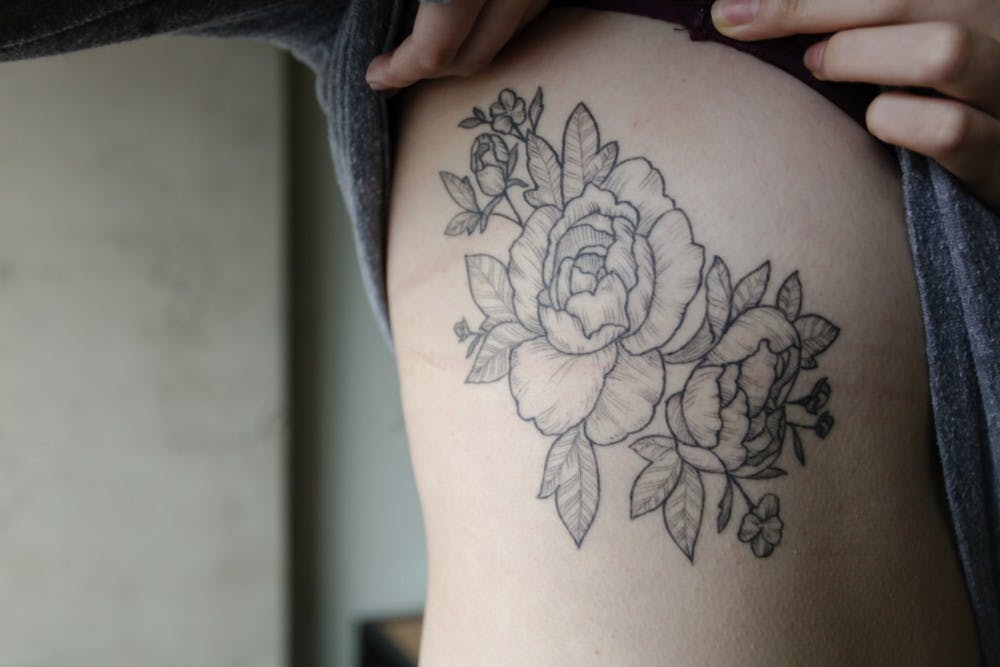Are you putting a bumper sticker on a Bentley or donning an artistic marker of your individuality? Depending on how you look at it, body modifications such as tattoos and piercings are forms of rebellion or self–expression. The decision to get your first tattoo can be especially daunting, although the prospect of permanence is tempered by the fact that laser removal is an option (and, coinciding with the rise of tattoos, growing in popularity). As of mid–2017, around 45 million Americans have tattoos. Thirty percent of them are between 18 and 25 years old.
“The first tattoo is the gateway tattoo for sure,” said Korbin Carnegie (C '18). She waved her hands as she spoke, drawing clear attention to the ink silhouettes of a flock of birds on the side of her forearm. She currently has three tattoos and nine piercings. Tattoos, and to a lesser extent, piercings, are life–long commitments that become easier to adopt after the first time. She got her first tattoo in January of her freshman year after about six months of planning.
“It says ‘La Vie en Rose’, which basically means seeing life through rose–colors,” she said. “I got it for two reasons: one, I’ve been taking French my whole life and absolutely love French language and culture, and two, it was so much like my grandparents’ relationship. They both passed, and they were just so in love to the very end, so I got this in memoriam of them as well.”
She’s gotten a new tattoo and a new piercing for every year of college so far. All of her tattoos are planned and have significant meaning to them, and she advises people who are interested in getting their first tattoo to wait six months to see if they’ll still want it by the end of that time.
But sometimes tattoos are impulse decisions, such as when Olivia Bridges (C ’20) got her first tattoo (out of six) when she was 17 years old. The subsequent ones were all planned a few weeks in advance, except for another impulse tattoo: a matching one with her best friend.
She wouldn’t say that it’s an addiction, “but after the first, you definitely realize how easy it is [to get one] and how accessible they are.”
Tattoos, while rising in popularity particularly among the millennial generation, still maintain a controversial presence on a campus obsessed with pre–professionalism. Korbin's only unconcealed tattoo is the one on her forearm that matches with her mother’s and sister’s, and is only visible due to her mother picking the location. She said, “If I had gotten to pick the location, it would’ve been covered, because I think that tattoos should be your own thing first and foremost, not for everyone else to talk about.”
On the other hand, Anastasia Dombrowski (C ’19) was very conscious about the specific placement of her most visible tattoo. “I knew I probably wasn’t going to go into some super conservative, professional place [for work], but I still want to be able to have a professional persona. I know that when I go into an interview, I’ll be wearing a button–down,” she said. “I measured how far up I roll up my sleeves and knew that as long as I got the tattoo above that line, I’d be fine.”
Currently she has three tattoos and 14–15 piercings. “There’s this little urge to get more after the first one. But just because tattoos are permanent, there’s more of an element of waiting on them than with piercings, which you can take out and can go away.”
The choice to get that tattoo you've been obsessing over on Instagram or the set of piercings you've seen on Pinterest is yours. Clearly, the decision to commit is much easier after the first time. Who knows—after you choose to get the tattoo or piercing at the top of your wish–list, you might end up getting them all.







